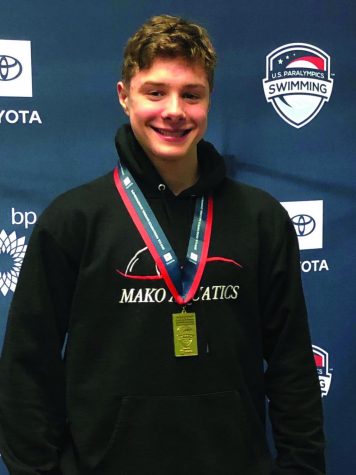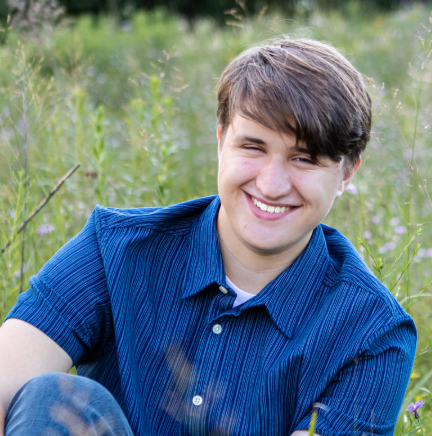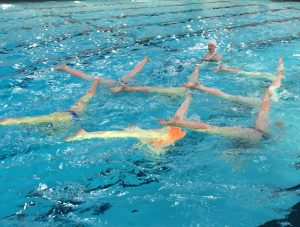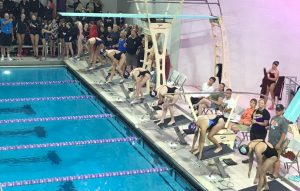Thomas Watry prepares for U.S. Paralympics team
It was 2014 when junior Thomas Watry went to his first national competition in Richmond, Va. It was a relatively small meet in comparison to future competitions he would take part in; however, the experience was overwhelming for him. It was his first tournament on an international level, with no parents and only his coach by his side. Around him crowds of students, families and friends cheered on competitors from all over the country.
What set this apart from other meets was the competitors themselves, who included anyone that fell under the broad label of “disabled”. This including those with visual impairments, legs, mental disabilities, dwarfism or those, like Thomas, who are missing a limb.
It was there that Thomas was first approached by organizers of the United States Paralympics team.
“I remember the big thing that really got me focused on trying to compete at the games or at least at a world level was when the head of the organization of United Paralympic swimming came up and said that they were tracking me to go to Tokyo in 2020,” Thomas Watry said, “Which, my being a kid kind of got me excited and ready to keep going.”
Since then, Thomas, who had his lower leg removed after complications with his birth, has been slowly working up towards competing in the Paralympic games. He has attended two other national meets and four international qualifiers over the past five years in order to ensure he is in proper condition to join the Paralympics team.
However, Thomas was not simply handed the position on a silver platter. He has anywhere from six to nine practices a week. These practices, which generally take either two or three hours each, occur inside an indoors pool. Each practice begin with a warm up and then is directly followed by two sets of aerobic and Race Paced Training activities.
Each activity takes about a half an hour. Their point is to build up a high metabolism so he can have a high lung capacity and endurance, which could make or break a close race. He also works on weight training in his spare time to build up muscle, which aids in giving him a more powerful thrust.
Even still Thomas, like all students, has had to struggle to maintain balance between school and practice, although he has begun to do a good job with it.

Junior Thomas Watry swimming at a meet.
“It’s pretty hard to balance our social lives with swimming when it’s two and a half hours a day,” explained senior Grant Allceims, a member of the swim team. “And we have two meets every week which go away at night 930 or 1030 at night…But I’ve never seen him in the locker room before practice, trying to get some homework done because that was the only time he had. He’s always hanging around with the guys.”
Beyond Preparation
While practices are one thing, the environment of events are another situation altogether. The diverse cast that the Paralympics and associated events brings together was originally a source of discomfort said Thomas.
“I know when I first started as 12 year old. I wasn’t very keen to the whole idea.” explained Thomas. “I almost felt like it was negative I didn’t like being segregated, I was still used to swimming with my peers around here…Now being with Maiko aquatics and working with my coach, I feel a lot better, a lot more comfortable in that environment and it was a lot more fun.”
With the Tokyo 2020 games in view life has become increasing stressful, but Thomas is looking forward to finally being able to making good on over five years of preparation. As for the opinion of the community at large, Thomas felt they would likely remain “dormant” to his competing because the Paralympics aren’t necessarily popular. Yes, he is happy in the idea, “that those who know me, my peers, my teachers, coaches, friends, anybody, they’ll recognize what’s happening.”

My name is Andrew Jurek and I’m a senior Layout editor-in-chief this year. I also enjoy reading (when I have the chance) but I spend most of my time...






Isaak Sahulka • Feb 5, 2020 at 10:26 pm
I love the detail that this story goes into about Thomas Watry. The story really shows off the hard work he has had to put in to get where she is now. Great job displaying the story of overcoming obstacle.
Sandra Liu • Feb 2, 2020 at 2:28 pm
You did a great job with this article! The writing has a nice, natural flow, and you really were able to capture how much work Thomas puts in to his time swimming. I liked how you included the various feelings that Thomas experienced throughout his journey towards the Paralympics – it really helped me, as a reader, to connect to the story.
Allison Benning • Jan 25, 2020 at 9:21 am
I loved this story! I thought it was very well written. It captured the emotion, while also having many strong facts. You also did a great job with your quotes. The article also flowed very well, which made it easier to read. Great job!
Kathleen Pothen • Jan 22, 2020 at 9:48 pm
The headline of your story immediately caught my attention because it had the word Paralympics, due to how large and prestigious the games are. I like in your lead you take the reader back to where this story really started at Thomas’ first big competition. It really shows how long and far he has come in his journey to reach this level of competition. I like that you included extent he has to practice each week. It shows the enormous amount of work he puts in. I also liked how you included some negative feelings Thomas felt because he was separated from other competitors, it showed an emotional side to the story. Really well written article. I really like the way it flows and the timeline it follows.